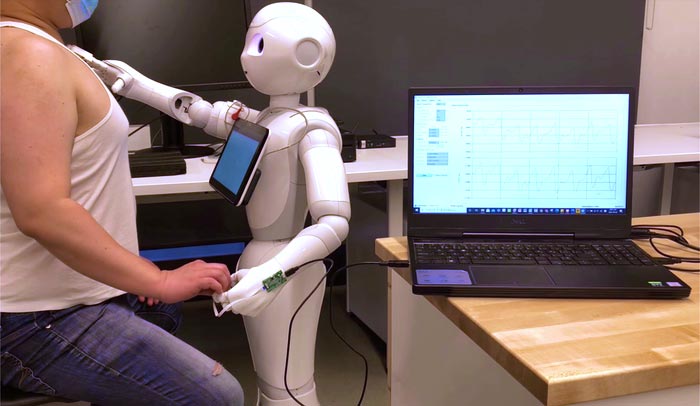Robots that can check your blood pressure …

Robot monitoring
Credit: SFU Additive Manufacturing Laboratory
… are the latest innovation from SFU
Empowering small, humanoid-sensing robots to take a patient’s blood pressure—using only a simple touch—is Simon Fraser University researcher Woo Soo Kim’s latest health care technology development.
Based on the intricacies of origami—and inspired by the movements of nature’s leeches—his research is advancing how robots could carry out basic health care tasks in certain conditions, including in remote regions, or where minimal personal contact is needed, such as during pandemics. The research is published in the journal npj Flexible Electronics from Nature Publishing Group.
Together with PhD student Tae-Ho Kim and a team in SFU’s Additive Manufacturing Lab, Kim and researchers have replaced the traditional blood pressure procedure by replicated the folding mechanisms of the leech in their design of 3-D printable origami sensors. The leech-inspired origami (LIO) sensors can be integrated onto the fingertips of a humanoid-sensing robot.
“Our origami-inspired dry electrode has unique characteristics such as suction for grasping and foldability inspired by nature,” says Kim, a professor and associate director of SFU’s School of Mechatronic Systems Engineering. “In keeping with nature, we saw that in addition to the complex mechanisms of a leech’s adhesive feature, these creatures have an expandable posterior sucker and body, while its organs expand and shrink appropriately to maintain better adhesion to its victim. Incorporating this point of view, we found that origami can achieve similar motions and also be customized.”
HOW IT WORKS
The LIO sensors integrated onto the robot’s fingertips can be positioned on the patient’s chest. Blood pressure is monitored and estimated by combining data from electrocardiogram (ECG)and photoplethysmogram (PPG) readings, as recorded by sensors on the fingers of each hand respectively.
Using predetermined algorithms, the signals from the paired sensors can generate a patient’s systolic and diastolic blood pressure without using the traditional cuff-based digital sphygmomanometer.
Kim’s earlier work involved programming sensing robots to measure other human physiological signals, such as those from an electrocardiogram (which monitors heart rate), temperature and respiration rate.
“Robotics offers a promising method to mitigate risk and improve patient care effectiveness and quality as focused remote healthcare technology,” says Kim. The researchers plan further trials of their new process and are developing the next generation of sensors, which they hope will lead to its biomedically meaningful implementation.
“Blood pressure monitoring is an essential medical diagnostic tool for many chronic diseases and overall good health. The use of sensing robots in medical healthcare systems has substantial advantages because they can assist health care workers in monitoring patient vital signs while creating a friendly environment for those patients who may need to be isolated.”
Kim believes that robotics can provide a future platform or bridge between medical personnel and remote patients with “the potential to play an essential role in the new era of remote healthcare.”
The research is partially supported by a Discovery and Accelerator Supplement Grant, funded by the Natural Sciences and Research Council of Canada (NSERC).
Journal: npj Flexible Electronics
DOI: 10.1038/s41528-022-00139-x
Article Title: 3D printed leech-inspired origami dry electrodes for electrophysiology sensing robots
Article Publication Date: 27-Jan-2022
All latest news from the category: Medical Engineering
The development of medical equipment, products and technical procedures is characterized by high research and development costs in a variety of fields related to the study of human medicine.
innovations-report provides informative and stimulating reports and articles on topics ranging from imaging processes, cell and tissue techniques, optical techniques, implants, orthopedic aids, clinical and medical office equipment, dialysis systems and x-ray/radiation monitoring devices to endoscopy, ultrasound, surgical techniques, and dental materials.
Newest articles

Innovative 3D printed scaffolds offer new hope for bone healing
Researchers at the Institute for Bioengineering of Catalonia have developed novel 3D printed PLA-CaP scaffolds that promote blood vessel formation, ensuring better healing and regeneration of bone tissue. Bone is…

The surprising role of gut infection in Alzheimer’s disease
ASU- and Banner Alzheimer’s Institute-led study implicates link between a common virus and the disease, which travels from the gut to the brain and may be a target for antiviral…

Molecular gardening: New enzymes discovered for protein modification pruning
How deubiquitinases USP53 and USP54 cleave long polyubiquitin chains and how the former is linked to liver disease in children. Deubiquitinases (DUBs) are enzymes used by cells to trim protein…



